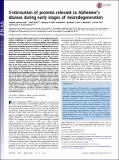S-nitrosation of proteins relevant to Alzheimer’s disease during early stages of neurodegeneration
Author(s)
Bhat, Vadiraja B.; Seneviratne, Uthpala Indrajith; Nott, Alexander; Kodihalli, Ravindra; Wishnok, John S; Tsai, Li-Huei; Tannenbaum, Steven R; ... Show more Show less
DownloadSeneviratne-2016-S-nitrosation of pro.pdf (1.110Mb)
PUBLISHER_POLICY
Publisher Policy
Article is made available in accordance with the publisher's policy and may be subject to US copyright law. Please refer to the publisher's site for terms of use.
Terms of use
Metadata
Show full item recordAbstract
Protein S-nitrosation (SNO-protein), the nitric oxide-mediated posttranslational modification of cysteine thiols, is an important regulatory mechanism of protein function in both physiological and pathological pathways. A key first step toward elucidating the mechanism by which S-nitrosation modulates a protein’s function is identification of the targeted cysteine residues. Here, we present a strategy for the simultaneous identification of SNO-cysteine sites and their cognate proteins to profile the brain of the CK-p25–inducible mouse model of Alzheimer’s disease-like neurodegeneration. The approach—SNOTRAP (SNO trapping by triaryl phosphine)—is a direct tagging strategy that uses phosphine-based chemical probes, allowing enrichment of SNO-peptides and their identification by liquid chromatography tandem mass spectrometry. SNOTRAP identified 313 endogenous SNO-sites in 251 proteins in the mouse brain, of which 135 SNO-proteins were detected only during neurodegeneration. S-nitrosation in the brain shows regional differences and becomes elevated during early stages of neurodegeneration in the CK-p25 mouse. The SNO-proteome during early neurodegeneration identified increased S-nitrosation of proteins important for synapse function, metabolism, and Alzheimer’s disease pathology. In the latter case, proteins related to amyloid precursor protein processing and secretion are S-nitrosated, correlating with increased amyloid formation. Sequence analysis of SNO-cysteine sites identified potential linear motifs that are altered under pathological conditions. Collectively, SNOTRAP is a direct tagging tool for global elucidation of the SNO-proteome, providing functional insights of endogenous SNO proteins in the brain and its dysregulation during neurodegeneration.
Date issued
2016-04Department
Massachusetts Institute of Technology. Department of Biological Engineering; Massachusetts Institute of Technology. Department of Brain and Cognitive Sciences; Massachusetts Institute of Technology. Department of Chemistry; Picower Institute for Learning and MemoryJournal
Proceedings of the National Academy of Sciences of the United States of America
Publisher
National Academy of Sciences (U.S.)
Citation
Seneviratne, Uthpala, Alexi Nott, Vadiraja B. Bhat, Kodihalli C. Ravindra, John S. Wishnok, Li-Huei Tsai, and Steven R. Tannenbaum. “ S-Nitrosation of Proteins Relevant to Alzheimer’s Disease During Early Stages of Neurodegeneration .” Proceedings of the National Academy of Sciences 113, no. 15 (March 24, 2016): 4152–4157.
Version: Final published version
ISSN
0027-8424
1091-6490